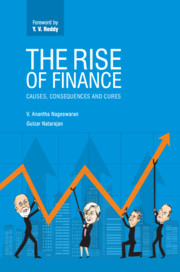Prologue
Published online by Cambridge University Press: 02 May 2019
Summary
As the Clinton presidency entered its final year in 2000, America removed the last vestiges of control on the financial services industry. The Commodities Futures Modernization Act was passed, paving the way for an explosion in the creation of financial derivatives. The Glass–Steagall Act that separated commercial banking from investment banking was repealed, enabling the creation of financial conglomerates.
The new millennium began with the collapse of the Internet and technology bubbles in the United States and elsewhere. The NASDAQ composite index crashed from 5,300 points to around 1,300 points. Then, there was 9/11. Surprisingly, the US economy endured only a brief and mild recession. In December of that year, China joined the World Trade Organization (WTO). In the United States, the Federal Reserve lowered the federal funds rate to 1.0 per cent. From 2002, a global economic recovery ensued, notwithstanding the invasion of Iraq in 2003, in search of weapons of mass destruction.
America pursued simultaneous wars in Afghanistan and Iraq. Government spending rose rapidly, and consumer spending even more so. The US dollar weakened but foreign governments, led by China and oil-producing nations, bought American debt copiously. Interest rates stayed low despite swift and big increase in government and private debt. Prices of commodities, including crude oil, boomed. Real estate prices boomed everywhere. Millions, including those with no income, no jobs and no assets, became homeowners, as lending standards were continuously diluted by successive governments. Securitization of mortgages happened at an unprecedented pace. New over-the-counter financial derivative contracts such as credit default swaps (CDSs) were created in the trillions. It all ended in 2007 as mortgage borrowers began to default and the real estate boom ended in America. The malaise soon spread to the rest of the world through financial channels. It climaxed with the collapse of Lehman Brothers, a big name on Wall Street. The world economy teetered on the edge of collapse.
In response, monetary policy turned unconventional. Unprecedented measures were adopted. The Federal Reserve set its policy rate – the federal funds rate – at 0 in December 2008 and held it there for seven years. In addition, the Federal Reserve targeted long-term interest rates through asset purchases.
- Type
- Chapter
- Information
- The Rise of FinanceCauses, Consequences and Cures, pp. xv - xviPublisher: Cambridge University PressPrint publication year: 2019



